Dogs have long been called “man’s best friend,” but how many facts about dogs do you know? This page will teach you all about dogs – how they came to live in peace with humans, why there are so many different breeds, why dogs behave the way they do and much more.

Where Did Dogs Come From?
Dogs as you see them today didn’t ‘evolve’ like most other animals.
Dogs don’t occur by themselves in nature – they were ‘created’ by humans through a couple of very deliberate processes.
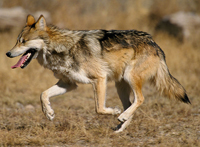
There’s still a bit of disagreement among scientists about how we got from wild wolves to the modern day Chihuahua. This is because attempts to domesticate animals these days – wild foxes, for example – have almost all failed.
Some people have tried to domesticate wolves, or create hybrids between dogs and wolves, but these animals have almost always ended up being aggressive and going back to ‘wild’ behavior.
The explanation usually given is that in the distant past, humans probably found wolf cubs and raised them as part of the ‘human family’ because of the way wolves could help them with hunting.

But it took a long time to go from this kind of domestic wolf to what could really be called a dog – the friendly, lovable pets we see everywhere today.
This would have been achieved by breeding the friendliest domestic wolves together over many years until a new species was created: the dog.
Another theory suggests that it was wolves who first saw the value of teaming up with humans, realizing they were better off eating scraps from animals that humans caught rather than trying to actually eat humans.
This theory says that wolves started coming in close to human camps to pick up leftovers about 12,000 years ago and the bond began to form.
10 Basic Dog Facts
Got some big questions about dogs? Perhaps these dog facts will answer some of them:
Number 1: Most dogs live around 12 to 15 years, although lifespan is different between breeds. The oldest dog recorded was 29.
Number 2: The relationship between humans and dogs is believed to stretch back 14,000 years.
Number 3: The tallest dog in the world is a Great Dane called ‘Giant George,’ who is over 43 inches tall (about 109 centimeters) and 245 pounds (about 111 kilograms).
Number 4: Dogs are omnivores – that means they eat both meat and plants.
Number 5: Dogs, wolves and foxes have a common ancestor in the ‘Miacis,’ a small creature that lived in trees 40 million years ago
Number 6: Chocolate is poisonous to dogs
Number 7: There are cave paintings of dogs in Spain which date back 12,000 years
Number 8: Just as every human has their own unique fingerprints, dogs all have a unique nose print – no two dog noses have the same pattern!
Number 9: The heaviest dog ever recorded was 290 pound (about 145 kilograms).
Number 10: The Labrador Retriever is the most common breed in America (according to registrations with the American Kennel Club)
There you go! Now you know 10 things about dogs that many people don’t know. Now let’s zoom in on some of the dog’s most fascinating features: how the dog’s anatomy works, how they behave, and their relationship with human beings throughout history.
Dog Anatomy
The dog’s anatomy reflects its ancestor and close cousin, the wolf.
Wolves and dogs both have sharp teeth and strong jaws. They have a warm coat which allow them to survive bad weather and tough outdoor conditions (except for breeds like the American Hairless Terrier, which, as the name suggests, has no hair!).
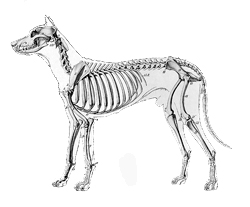
The shape of a dog’s ears differ from breed to breed. Dogs with ears that stand up straight can generally hear better than dogs with floppy ears. The pointy ears are similar to those of the dog’s wild relatives like the fox and wolf.
Another interesting thing about dogs is that breeds with shorter snouts, like the bulldog, tend to have shorter lifespan than dogs with ‘wolf-like’ faces.
This is largely because breeds like the bulldogs have been ‘inbred’ within a fairly small gene pool, and the result of that is a greater risk of genetic diseases and problems.
This is not true of every breed (some ‘wolf-like’ dogs have short lifespan too) but it’s a general rule of thumb.
The dog’s tail is one of the most important parts of its anatomy.
Dogs use their tails for a kind of ‘sign language’ – they communicate a lot about what is going on inside their heads, through what they do with their tails. A loose, wagging tail usually indicates excitement. A limp tail hung between the legs can be a sign of fear or anxiety (dogs often do this when their owners give them a telling off for going to the toilet inside)
Here’s a fascinating fact about dog anatomy: unlike a human, a dog’s shoulder blades aren’t actually joined up to the rest of the skeleton. This allows dogs to more be flexible and run faster as a result.
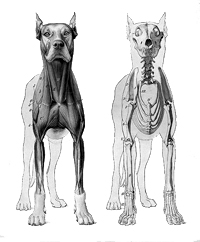
While many common dog health problems relate to joints, a few are created by the habits of their owners.
For example, obesity is becoming quite a problem for dogs these days as their owners feed them too much. Obesity can lead to all sorts of health problems, including diabetes. There’s no ‘ideal weight’ for all dogs since there’s a huge difference in size between breeds, but every breed has an ideal weight range. You should find out what the ideal weight range is for your dog and weight her to make sure she fits in (or isn’t too far to either side).
If she’s overweight, a diet change and more exercise are in order. Underfeeding is also a big problem – as a general rule of thumb, if you can see your dog’s ribs she probably isn’t getting enough food (although some breeds, like greyhounds, tend to be naturally lean even when they’re at a healthy weight).
But the most fascinating facts about dog anatomy surround the dog’s senses – in particular its amazing hearing and sense of smell.
Dogs ‘see’ the world a lot differently from human beings.
Let’s take a look at dog senses now.
The Senses of a Dog
Sight
It’s a fairly well-known fact that dogs’ eyesight is worse than humans, but many people falsely believe dogs only see in black and white.
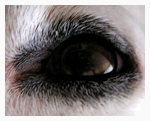
There are some colors of the color spectrum dogs can’t see, but they can see a few – mostly blue and yellow.
Dogs can focus their eyes as well as humans can, but they can generally see movement better than we can.
This is why ‘sight hounds’ are useful for hunting animals like rabbits, that move quickly – but it also explains why a dog often won’t see a cat that’s sitting perfectly still.
It also explains why a dog can often hear something nearby without actually being able to see it.
Smell
The dog’s sense of smell is its strongest, along with hearing.
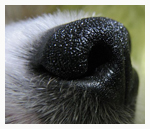
In fact, scientists have discovered that dogs in general have about 44 times as many cells dedicated to picking up smells compared to humans. Most of the ‘scent hounds’ – dogs used for hunting by smell – have even more smelling cells than this.
But just the number of cells dedicated to picking up smell doesn’t do the dog’s sense of smell justice – difference between dog brains and human brains when it comes to processing smells has led some scientists to believe that the dog’s sense of smell with a full stomach is 800.000 better than ours, and on an empty stomach may actually be up to 2,4 million times stronger than ours.
Now you know why your dog is so interested in sniffing everything you come across when you go for a walk!
The dog’s nose has a vacuum effect!
The dog breath in through the two nostrils and blow out through the slit in the nose. As the dog keeps it’s nose close to the ground, this creates a vacuum effect that gives the maximum scent.
A dog will always go for the strongest source of the smell, which makes the dog follow the trail to the wounded animal.
Dogs can distinguish between more than 2000 different smells at the same time, while humans can distinguish between op to 24 smells at the same time.
The god’s sense of smell is affected by stress, compulsion and jerking of the collar, which means that you cannot work with these factors present when working with tracking.
Touch
Dogs don’t rely on their sense of touch as much as hearing and smell, but it’s still important.
In the wild, dogs sleep bundled up together with the rest of their pack – this is partly for keeping warm, but it’s likely that they also enjoy the touch of other dogs.
This is why dogs enjoy being stroked and petted by humans.
Taste
Anybody who has ever tried to change their pet dog’s food and found Fido suddenly refuses to eat knows dogs have a sense of taste – although they don’t tend to be as picky with their food at most humans!
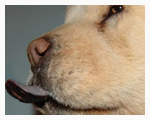
Dogs can certainly recognize some flavors, although it’s doubtful that their sense of taste is as complex as ours.
They only have about 1700 taste buds on average, compared to about 9000 in humans.
But they are capable of knowing whether something is salty or sweet, for example.
Hearing
Anyone who has ever seen the effects of a ‘dog whistle’ – a whistle so high-pitched that dogs can hear it but humans can’t – understands that dogs are living in a bit of a different world when it comes to the sounds they hear.
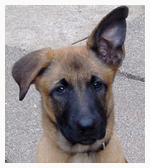
Often dog owners wonder why their dog will start behaving strangely for no reason or ‘barking at nothing’ – this is why.
They can hear things we’re completely unaware of. Not only can they hear frequencies they can’t, but their ears are just a lot more sensitive so they can hear things that are too quiet for our ears to pick up.
On top of this, they have muscles in their ears which they can control to point each ear in different directions, allow them to more easily pick up sounds all around them.
————————
As you can see from all this, even though you and your dog are experiencing the same world every day you experience it in very different ways.
Hopefully this will help you understand why dogs sometimes act in unusual ways. But to really understand why dogs do what they do, we need to take a closer look at dog behavior.
Dog Behavior
Since so many of us live out our daily lives with dogs around, understanding dog behavior isn’t just interesting – it’s actually useful and necessary.
Knowing why a dog behaves in a certain way lets you understand how to deal with the behavior, which is especially handy if the behavior is something annoying or dangerous.
First of all, let’s discuss how wolves and dogs act in the wild.
This is important because much of the way a dog behaves is based on instinct, and instincts don’t change much over tens of thousands of years. By looking at how dogs act in the wild, you can understand why they do certain things in a home setting that seem unusual.
First – dogs are pack animals.
They are used to living in groups. They eat and sleep together in groups.
People who come up against behavior problems like ‘behavior anxiety’ often don’t understand this. They can’t understand why their dog gets so stressed out about being left alone.
It’s because for a dog in the wild, being alone is dangerous! The pack is a dog’s source of protection from other animals, its ‘team’ to catch food with, and its source of warmth in cold weather. Of course dogs don’t like being alone!
Every pack has a hierarchy – a structure which lets each dog know who’s the boss and who are the followers.
In dog training, it’s important for humans to avoid letting the dog think he’s the pack leader. This leads to all kinds of behavior problems, because a dog who believes he’s the pack leader will literally do whatever he wants.
Dogs are also ‘den dwelling’ animals, meaning they tend to live in caves or some other type of sheltered area.
They are territorial – they have their den and their surrounding hunting ground. The den is the place for sleeping and eating, so they know not to go to the toilet there. (Important information for puppy owners trying to figure out how to potty train their new family member!)
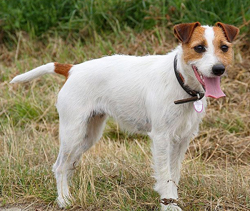
Okay, so those are some facts about dogs in the wild – but what about how domestic dogs behave? After all, the habits of wild dogs can explain a few things about how pet dogs act, but not everything. A lot of the behavior of a house dog or working dog has to do with the specific breed, and what it was bred for.
Breeds aren’t accidental.
Every breed of dog you see was bred to do something in particular.
The Irish wolfhound, for example, were bred to hunt wolves.
Jack Russell terriers and fox terriers were bred for fox hunting.
Golden retrievers were bred to retrieve dead animals shot by hunters.
All these dogs have their own unique behaviors that reflect their breeding. For example, golden retrievers like to chase balls and play fetch, but a Jack Russell might prefer digging holes in the ground.
Learning about a particular dog breed’s background will help you understand why a dog acts the way it does
The Largest Dog in the World
Giant George, mentioned above, is the world’s largest dog according to the Guinness Book of World Records. I said above that George stands at about 43 inches tall – but what I didn’t mention was that he measures about 7 feet long from nose to tail (about 2.1 meters). That’s the height of many NBA basketball players.
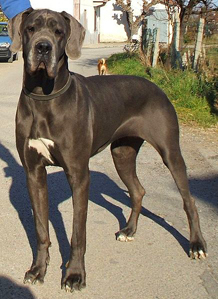
There was a photo floating around the Internet claiming to be of ‘Hercules, the world’s largest dog.’ The photo showed a dog which was almost as large as a horse – but of course, the photo turned out to be fake. George is still the official champion in the biggest dog stakes.
George is a Great Dane. The other dog breed that rivals the Great Dane is the Irish Wolfhound. These dogs are usually around 30 inches (about 76 centimeters) high and weigh in at about 121 to 143 pounds (55-65 kg).
Types of Dog
There are over 400 breeds of dog in the world today.
I won’t give you a full list here, but let’s take a look at the ‘groups’ the dog breeds are divided into. These groupings help make it easier to understand what different breeds were developed for and why a beagle behaves differently from a chihuahua.
The groups are, according to the AKC: Toy, Sporting, Non-Sporting, Hound, Working, Herding and Terrier.
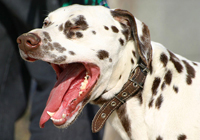
The Dalmatian, which has become so popular largely thanks to the story of 101 Dalmatians, has quite a strange origin.
This is one of the ‘non-sporting’ group dogs. They were bred as guard dogs, but they had a very specific job to do: they would clear the way for a fire department cart (back when fire departments used horse-drawn carts!) and then guard the cart while it was unattended.
This strange story of origin is why the Dalmatian is still closely associated with the fire department even to this day.
Above I mentioned the American Hairless Terrier – the dog with no coat.
It may come as a surprise to you to learn there are actually also ‘coated American Hairless Terriers’ – versions which do have hair! It seems a little strange, but this is the way the American Kennel Club has decided to classify these dogs.
Hopefully a better name will be thought of some time in the near future!
The Dog Whisperer
‘The Dog Whisperer’ is the name of a famous dog trainer, Cesar Millan, and the title of his TV show. Millan is well-known for his ‘tough love’ approach to dog training.
Although he has taken a lot of criticism, Millan has done a lot of good introducing dog training techniques into the homes of millions of people who would otherwise be struggling with their out of control pets.
Today you can find several excellent dog trainers, some of them with TV shows. They really know how to help a dog and it’s owner to make their life work for both parts.
‘The Dogs of War’
The famous line ‘Cry havoc and let slip the dogs of war,’ from Shakespeare’s play Julius Caeser, was actually about human soldiers, not dogs.
But dogs have been used in warfare for many centuries, stretching back to Roman times and before. When we think of historic battles, horses are usually the animals that spring to mind, but dogs have played equally important roles in winning important fights throughout history.
They aren’t used only as attack dogs, however.
Dogs these days still play big roles in the military and police forces of many countries. Dogs with great senses of smell, like the beagle, are used in airports for their ability to sniff out bombs and drugs in luggage. Dogs are still used by the US military to this day.
The Human’s Best Friend – More Than Just a Name
The nickname ‘man’s best friend’ has been around for centuries.
But modern science has allowed us to figure out exactly what effects having a dog around can have on people.
Studies have found that there’s is a real and measurable effect on human happiness that comes from having a friendship with a dog. In fact, ‘pet therapy’ is now a common prescription for many people suffering from mental disorders.